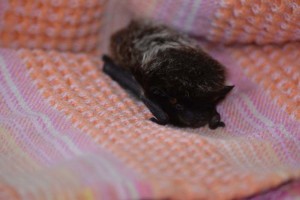Bats are well known for hibernating during the cold winter months, but did you know that some species of Ontario bats have a different winter strategy? They fly south!
On warm nights in these southerly climates, they may continue to forage for insects throughout the winter. During cold spells, they enter a state of torpor under the leaf litter of the forest floor, in the tree canopy, or in a hollow in a tree.
However, migrating bats can get disoriented among the dense high-rises of the downtown core, and either get hurt flying into buildings or end up confused and grounded, unable to find their way out. Toronto Wildlife Centre admits silver-haired (like the one above), red and hoary bats each migration season, especially in the fall.
Wildlife Tip:
If you find a bat on the ground unable to fly, or awake inside during the winter, it likely needs help. Contain it by placing a plastic container, like a clean Tupperware or margarine tub, over the bat (do not touch the bat with your bare hands). Poke holes in the lid, and slide it under the tub to close the container.
Call Toronto Wildlife Centre’s Hotline at 416 631 0662 for advice.
Th ank you to TD Friends of the Environment for generously supporting Toronto Wildlife Centre’s bat rehabilitation program
ank you to TD Friends of the Environment for generously supporting Toronto Wildlife Centre’s bat rehabilitation program

